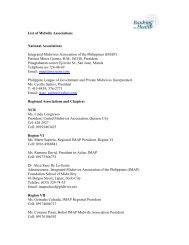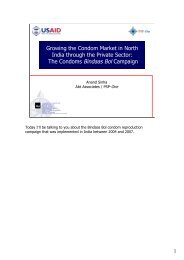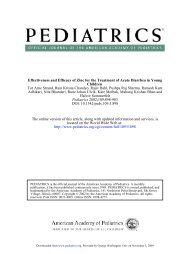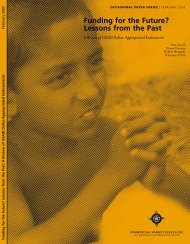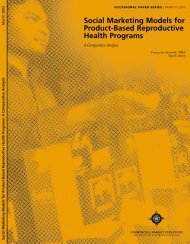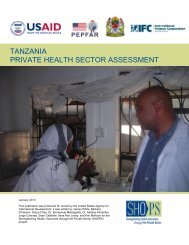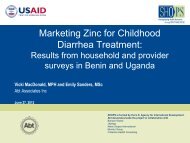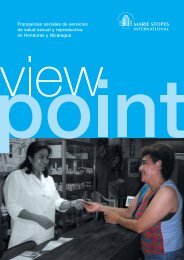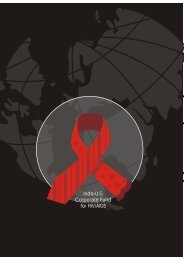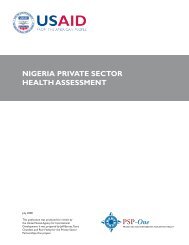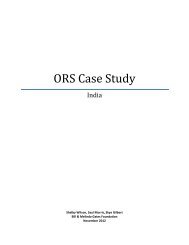identifying at risk populations and hiv/aids referral ... - (SHOPS) project
identifying at risk populations and hiv/aids referral ... - (SHOPS) project
identifying at risk populations and hiv/aids referral ... - (SHOPS) project
- No tags were found...
Create successful ePaper yourself
Turn your PDF publications into a flip-book with our unique Google optimized e-Paper software.
3. METHODOLOGY<br />
3.1 STUDY DESIGN<br />
The study design had a three-pronged approach. First, the authors conducted a comprehensive review<br />
of published <strong>and</strong> unpublished reports to g<strong>at</strong>her inform<strong>at</strong>ion on MARPs in Oromiya region. Second, the<br />
assessment used two qualit<strong>at</strong>ive study techniques, key informant interviews <strong>and</strong> focus group discussions<br />
(FGDs), with different groups th<strong>at</strong> represent MARPs. Finally, d<strong>at</strong>a <strong>and</strong> inform<strong>at</strong>ion were g<strong>at</strong>hered from<br />
key institutional records. The MARP groups included in-school <strong>and</strong> out-of-school youth, mobile/migrant<br />
workers or day laborers, <strong>and</strong> female commercial sex workers (FSWs). The key informants were heads<br />
of woreda HIV/AIDS Prevention <strong>and</strong> Control Offices (HAPCOs), health offices, <strong>and</strong> local NGOs; health<br />
facility providers; <strong>and</strong> care <strong>and</strong> support groups. Nine FGDs were conducted: three with in-school youth,<br />
three with out-of-school youth, <strong>and</strong> three with migrant day laborers. Nine in-depth interviews with<br />
FSWs were conducted.<br />
The aim of the FGDs was to identify main predisposing factors for <strong>risk</strong> behaviors, <strong>and</strong> to find out who<br />
are the most <strong>at</strong> <strong>risk</strong> <strong>and</strong> whether <strong>and</strong> how they are being reached by HIV/AIDS/sexually transmitted<br />
infection (STI)-rel<strong>at</strong>ed messages <strong>and</strong> services. The discussions included issues rel<strong>at</strong>ed to participants’<br />
<strong>at</strong>titudes toward HCT service providers in general <strong>and</strong> toward new HCT modalities such as mobile<br />
HCT in particular. They also discussed which service delivery options <strong>and</strong> timing would be suitable to<br />
each target groups. In-depth interviews were conducted with women <strong>identifying</strong> themselves as CSWs.<br />
3.2 STUDY SITES<br />
The study was conducted in 10 towns of Oromiya region (Table 1). The towns were selected based on<br />
criteria such as having a rel<strong>at</strong>ively large popul<strong>at</strong>ion, informal knowledge of traffic load, <strong>and</strong> a number of<br />
migrant workers. The towns are on the highways from Dukem to Shashemene <strong>and</strong> from Modjo to<br />
Adama, intern<strong>at</strong>ional roads th<strong>at</strong> link Ethiopia with Djibouti <strong>and</strong> Kenya, respectively. The roads are busy,<br />
with high concentr<strong>at</strong>ions of bars, hotels, <strong>and</strong> commercial sex. Moreover, numerous industries <strong>and</strong><br />
plant<strong>at</strong>ions <strong>at</strong>tract many migrant workers. The growth of flower plant<strong>at</strong>ions in the past few years has<br />
gre<strong>at</strong>ly increased the number of migrant workers, especially on the Dukem−Shashemene route.<br />
TABLE 1. STUDY SITES IN OROMIYA REGION<br />
Southeast<br />
East<br />
Region<br />
Dukem<br />
Bushofto<br />
Modjo<br />
Meki<br />
Zeway<br />
Arsi Negele<br />
Shashemene<br />
Adama<br />
Wonji<br />
Metehara<br />
Main towns<br />
5



